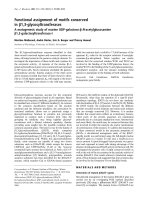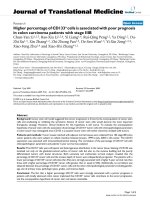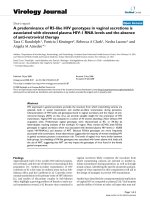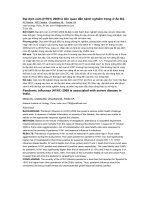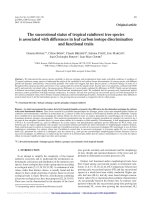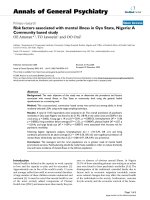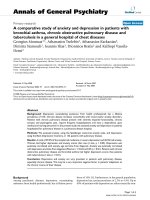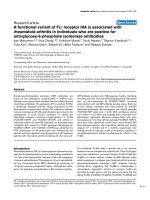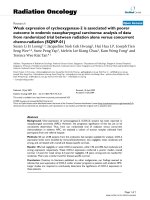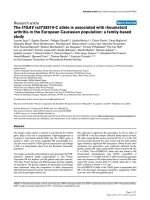Worry is associated with robust reductions in heart rate variability: A transdiagnostic study of anxiety psychopathology
Bạn đang xem bản rút gọn của tài liệu. Xem và tải ngay bản đầy đủ của tài liệu tại đây (789.81 KB, 9 trang )
Chalmers et al. BMC Psychology (2016) 4:32
DOI 10.1186/s40359-016-0138-z
RESEARCH ARTICLE
Open Access
Worry is associated with robust reductions
in heart rate variability: a transdiagnostic
study of anxiety psychopathology
John A. Chalmers1, James A. J. Heathers1,2, Maree J. Abbott1, Andrew H. Kemp1,3,4 and Daniel S. Quintana1,5,6*
Abstract
Background: Individuals with anxiety disorders display reduced resting-state heart rate variability (HRV), although
findings have been contradictory and the role of specific symptoms has been less clear. It is possible that HRV
reductions may transcend diagnostic categories, consistent with dimensional-trait models of psychopathology.
Here we investigated whether anxiety disorders or symptoms of anxiety, stress, worry and depression are more
strongly associated with resting-state HRV.
Methods: Resting-state HRV was calculated in participants with clinical anxiety (n = 25) and healthy controls (n = 58).
Symptom severity measures of worry, anxiety, stress, and depression were also collected from participants,
regardless of diagnosis.
Results: Participants who fulfilled DSM-IV criteria for an anxiety disorder displayed diminished HRV, a difference
at trend level significance (p = .1, Hedges’ g = -.37, BF10 = .84). High worriers (Total n = 41; n = 22 diagnosed
with an anxiety disorder and n = 19 not meeting criteria for any psychopathology) displayed a robust reduction
in resting state HRV relative to low worriers (p = .001, Hedges’ g = -.75, BF10 = 28.16).
Conclusions: The specific symptom of worry – not the diagnosis of an anxiety disorder – was associated with the most
robust reductions in HRV, indicating that HRV may provide a transdiagnostic biomarker of worry. These results enhance
understanding of the relationship between the cardiac autonomic nervous system and anxiety psychopathology,
providing support for dimensional-trait models consistent with the Research Domain Criteria framework.
Keywords: Psychophysiology, Autonomic nervous system, ANS, Heart rate variability, HRV, Anxiety, Worry,
Dimensional-trait models
Background
Anxiety disorders are the most prevalent of the psychiatric
disorders [1], and the most costly [2]. Anxiety disorders
carry a three to four-fold increased risk of cardiovascular
disease (CVD) after accounting for gender, substance use,
and depression, [3–5] and a two-fold increased risk for
cardiac mortality [6–8]. Reductions in resting-state heart
rate variability (HRV) reflect cardiac autonomic dysfunction, which plays a key role in the development of cardiovascular diseases. Although reductions in HRV may
* Correspondence:
1
School of Psychology, University of Sydney, Sydney, Australia
5
NORMENT, KG Jebsen Centre for Psychosis Research, Division of Mental
Health and Addiction, University of Oslo, and Oslo University Hospital, Oslo,
Norway
Full list of author information is available at the end of the article
provide a link between anxiety and ill health [9–13],
past studies on anxiety disorders have reported contradictory findings. Here we sought to determine whether
anxiety disorders or their symptoms spanning a nonclinical to clinical spectrum are associated with stronger
relations with HRV.
HRV indexes the complex modification of heart rate
over time and has become a widely used measure of
autonomic control of heart rate. Low HRV is associated
with a wide variety of psychological states, behaviours and
conditions including reduced capacity for self-regulation,
enhanced withdrawal behaviours, psychiatric illness and
cardiovascular disease [14–19] leading us to suggest
previously that HRV may help to elucidate the pathways linking mental and physical health [13]. Anxiety
© 2016 The Author(s). Open Access This article is distributed under the terms of the Creative Commons Attribution 4.0
International License ( which permits unrestricted use, distribution, and
reproduction in any medium, provided you give appropriate credit to the original author(s) and the source, provide a link to
the Creative Commons license, and indicate if changes were made. The Creative Commons Public Domain Dedication waiver
( applies to the data made available in this article, unless otherwise stated.
Chalmers et al. BMC Psychology (2016) 4:32
disorders have been characterised by low HRV [20] and
two complementary models – polyvagal theory and neurovisceral integration – provide a platform on which these
findings may be interpreted.
Polyvagal theory [21] links high resting-state HRV to
social engagement and effective emotion regulation
strategies, while low HRV is linked to withdrawal behaviours [21], a characteristic that may underpin many
of the anxiety disorders. An alternative biobehavioural
theory, the neurovisceral integration model [22, 23],
further underscores the important inhibitory role of vagal
activity in emotion regulation. This model outlines specific
central and peripheral pathways that connect autonomic,
attentional, and affective systems involved in emotion
regulation. The model suggests that the integrity of these
pathways may be compromised in anxiety disorders, such
that the central and autonomic nervous systems are rigidly
coupled, resulting in difficulty with disengaging from and
inhibiting threat detection (e.g., hyper-vigilance, apprehension, avoidance, panic sensations, increases in heart rate,
and decreases in HRV).
While studies on HRV in the anxiety disorders have reported contradictory findings, recent meta-analytic work
has established that anxiety disorders are associated with
poor autonomic function [24–26]. However, it remains
unclear whether specific symptoms characteristic to the
anxiety disorders or the disorder itself are characterised by
the most robust associations. The finding that reduced
HRV is a common feature of anxiety disorders (except
perhaps obsessive-compulsive disorder; OCD) [20] may be
interpreted within a dimensional-trait model of psychopathology [27] in which HRV reductions may reflect a
failure to inhibit stereotypical fight-flight-freeze behavioural responses [21–23]. However, prior studies have
typically focused on distinct nosological disorders rather than on transdiagnostic features of anxiety symptomatology. This is an important distinction because
most psychological disorders are heterogeneous and
symptoms may also be present in individuals that do not
meet formal diagnostic criteria. Moreover, anxiety symptomatology is present in a wide range of psychiatric disorders. Therefore, in addition to comparing HRV in those
with and without an anxiety disorder, we also determined
whether participants high versus low on specific symptoms are associated with more robust reductions in HRV,
regardless of diagnosis.
Methods
The current study was undertaken and reported in accordance with the Guidelines for Reporting on Articles
on Psychiatry and Heart rate variability (GRAPH) [28],
which provides a standardized set of criteria for reporting HRV studies in the biobehavioral sciences [see
Additional file 1].
Page 2 of 9
Participants
Ninety-one participants (mean age = 19.70, age range:
17–29) were recruited for the present study including 27
who met diagnostic criteria for a DSM-IV anxiety disorder, and 64 control participants that did not meet any
DSM-IV diagnostic criteria. Participants were recruited
from an undergraduate participant pool and received
course credit for participation. In a typical sample of
undergraduate students, the prevalence of anxiety with
clinical severity is relatively low. Therefore, in an effort
to recruit participants experiencing high levels of anxiety,
participants were recruited based on responses to the Depression Anxiety Stress Scales – Short Form (DASS-21)
[29], a screening measure. At the beginning of semester, a
cohort of undergraduate psychology students completed a
battery of measures including the DASS-21, allowing
for targeted recruitment. In the present study, targeted
participants included those who scored in the severe-toextremely severe range on anxiety scale of the DASS-21.
After providing written informed consent, all participants were administered the Anxiety Disorders Interview Schedule-IV for DSM-IV (ADIS-IV) [30] by one of
two trained doctoral students (JAC or DSQ) to assess
whether participants met DSM-IV criteria for an anxiety
disorder. At the time of data collection, JAC had had extensive experience in administering the ADIS-IV through
his studies as part of the doctorate of clinical psychology
programme. DSQ was a PhD candidate in psychology and
was provided with training and supervision in the administration of the ADIS-IV by JAC and MJAA, a clinical
psychologist and senior lecturer in clinical psychology. All
participants were provided with details of multiple mental
health services they could access after testing, if required
(e.g., if they reported significant distress). Control group
participants did not meet criteria for any psychiatric
disorder. All aspects of the study were approved by The
University of Sydney’s Human Research Ethics Committee.
Exclusion criteria for the study included self-reported
chronic physical illness (e.g., cardiac illness, cancer, epilepsy,
and diabetes mellitus), psychotropic medication, pregnancy
or lactation, psychosis spectrum disorder, traumatic brain
injury, substance or alcohol dependence. Participants were
instructed not to consume caffeine or nicotine on the day
of their laboratory visit. Body mass index (BMI; assessed
with a standard scale and tape measure) and an assessment
of alcohol intake using the Alcohol Use Disorders Identification Test (AUDIT) [31] were calculated due to previously
reported relationships with HRV [19, 32].
Measures
Anxiety Disorders Interview Schedule for DSM-IV (ADIS-IV)
[30]. The ADIS-IV is a semi-structured clinical interview based on DSM-IV-TR criteria, and is designed as a
diagnostic tool for Axis-I disorders including anxiety
Chalmers et al. BMC Psychology (2016) 4:32
and mood disorders. A clinical diagnosis was indicated by
a clinical severity rating (CSR) of at least four on the clinical scale. The CSR is a rating made by the interviewing
clinician (JAC or DSQ) on a 0 to 8 scale based on current
symptom severity, distress, and interference (0 = none,
2 = subclinical, 4 = clinically significant, 6 = moderately
severe, 8 = most severe).
Penn State Worry Questionnaire (PSWQ) [33]. The
PSWQ is a 16-item self-report questionnaire designed
to assess intensity and excessive worry. Items include “my
worries overwhelm me” and “I worry all the time”, and are
presented on a 5-point Likert-type scale. The PSWQ has
been shown to have good internal consistency [34] and
well-established validity [35]. The internal consistency in
this study was found to be good (α = .80).
Depression Anxiety Stress Scales – Short Form (DASS-21)
[29]. The DASS-21 is a self report scale assessing levels
of depression, anxiety, and stress over the previous week,
and consists of three scales: depression (DASS-D), anxiety
(DASS-A), and stress (DASS-S). Items are rated on a 4point Likert-type scale, with higher scores reflecting
higher levels of depression, anxiety, or stress. The measure
displays good-to-excellent reliability and validity [36].
Internal consistency of the three subscales was found to
be good in the current study (α’s ranged from .88–.95).
The State-Trait Anxiety Inventory (revised STAI-Y)
[37]. The STAI-state subscale (STAI-S) is a brief scale,
consisting of 20 items coded on a 4-point Likert scale,
designed to measure transient emotional reactions. The
STAI-S good concurrent validity (α = .75–.85) and testretest reliability in general: α = .73–.86 [37].
Definition of groups
First, participants were grouped by diagnostic category
according to whether diagnostic criteria were met for a
primary diagnosis of an anxiety disorder as assessed by
the ADIS-IV. While the analyses compared clinically
anxious participants with non-anxious controls, associations with different dimensional indices of symptom
severity, including depression, a symptom that is frequently comorbid with anxiety, were of primary interest
[38]. Therefore, all participants, regardless of disorder
diagnosis, were also divided into groups of high and
low levels of symptom severity for worry, depression,
anxiety, and stress, as defined by the PSWQ and the
depression and anxiety subscales of the DASS-21 respectively. The cut-off for the high levels of worry
symptoms from the PSWQ was 45 [39]. The anxiety
and depression subscales of the DASS-21 were categorised
into high symptom severity (severe to extremely severe;
scores ≥ 21 on the depression subscale, scores ≥ 15 on the
anxiety subscale, and scores ≥ 26 on the stress subscale) and low symptom severity (normal to moderate;
scores ≤ 20 on the depression subscale, scores ≤ 14 on
Page 3 of 9
the anxiety subscale, and scores ≤ 25 on the stress subscale), using severity labels previously described based
on normative data [29].
Procedure
After informed consent was obtained, participants were
asked to complete the state-trait anxiety inventory for a
measure of state anxiety (STAI-S). Thereafter, a brief
medical and psychological history was obtained by
trained doctoral students. Arterial blood pressure was
also recorded. Participants then underwent the structured diagnostic interview (ADIS-IV), which varied in
duration between 45 minutes and 90 minutes depending on clinical severity of the participant, after which a
battery of questionnaires was completed. Electrocardiogram (ECG) electrodes were then attached and data
was recorded for six minutes while participants were
relaxed and in a seated position. No instructions were
given to alter breathing to avoid confounding associated with visceral-medullary feedback.
Physiological data recording and processing
Ag/AgCl electrodes were attached in a modified Lead-II
formation (right clavicle and left iliac crest) with a reference
electrode on the left clavicle, and connected to an ECG,
which sampled at 1000 Hz (PowerLab 8/30: ADInstruments, Sydney, AUS). ECG R-R series was obtained by the
identification of the zero-points after a local maximum of
the first derivative series via dedicated software (HRV
Module, Labchart, ADI). All relevant segments were
visually inspected and corrected for false or undetected
R-waves, movement artifacts, and ectopic beats using
piecewise cubic spline interpolation, with assessor blind
to group status. Participants exhibiting significant deviation from sinus rhythm and electromyographic or movement errors (i.e., > 0.5 % of total beats) were excluded
from the study. A frequency domain measure approximating the activity of respiratory sinus arrhythmia (high frequency, .15Hz–.40Hz; HF) was calculated by Fast Fourier
Transform using Welch's Periodogram (window width
256s, 50 % overlap, resampled at 4 Hz). This measure
of HRV was chosen as it best reflects parasympathetic
modulation of the heart [40]. HRV metrics were calculated
using Kubios (v2.0, Biosignal Analysis and Medical Imaging Group, University of Kuopio, Finland). HF-HRV violated Shapiro–Wilk's test for normality (all ps < .05), so
raw scores were log transformed.
Statistical analysis
Analyses were conducted using the “perfect t-test” script
[41] and “stats” package in the R statistical environment
(version 3.2.2). Welch’s t-tests and Pearson’s Chi-square
test compared differences between groups on relevant
demographic variables, including age and gender, to
Chalmers et al. BMC Psychology (2016) 4:32
assess whether groups differed on common factors known
to impact HRV. Welch’s t-tests were also used to compare
HF HRV between groups. The common language effect
size was computed, giving the probability that one random
group observation is higher than another random observation from the other group [42]. Hedges’ g was also calculated as an effect size measure; this measure is better
suited to studies with small sample sizes than the Cohen's
d measure [43]. Bayes Factors (BF10) were calculated to
quantify evidence for the alternative hypothesis (H1)
relative to the null hypothesis (H0) [44] with a noninformative Jeffreys prior placed on the variance of the
normal population and a Cauchy prior placed on the
standardized effect size. The Bayes factor r-scale prior
(not to be confused with Pearson’s r correlation coefficient)
was set at 0.5, as a small effect size was anticipated. A BF10
value < 0.33 provides strong or ‘substantial’ evidence for
the null hypothesis, over 3 provides strong evidence for the
alternative hypothesis and between 0.33 and 3 provides
only anecdotal support either way [45]. To investigate the
relationship between HRV and variables of interest, correlational analyses were conducted across all participants with
two-tailed Pearson correlations and Bayes Factors (putting
a uniform prior on rho) using the JASP statistical package (version 0.7.5.5) [46]. The importance of reporting
effect sizes regardless of statistical significance has been
highlighted previously [5, 47, 48], and these recommendations are followed here. The correlation coefficient
was interpreted as large when r = .5, medium when r = .3,
and small when r = .10, while Hedges’ g was interpreted as
large when g = .80, medium when g = .50, and small when
g = .20.
Results
Participant characteristics
After blinded inspection of the ECG data, eight participants were excluded due to artefacts or significant deviations from sinus rhythm that comprised more than 0.5 %
of total beats over the six-minute recording (ECG data
available upon request), leaving a sample of 83 participants. Table 1 presents the participant characteristics for
the control and clinical groups. There were no significant
differences between groups on age, gender, and alcohol
use. The clinical group had a significantly lower BMI than
the control group (p = 0.04, Hedges’ g = 0.44; Table 1),
however, a BF10 of 1.78 indicates the data are only 1.78
times more likely under the alternative hypothesis (than
under the null hypothesis) providing only anecdotal evidence for the alternative hypothesis. Moreover, BMI was
not significantly correlated with HRV (r = 0.02; 95 % CI: -.2
to .24; p = .84), with the BF providing substantial evidence
that these variables are not related (BF10 = .14). These
findings suggest that group differences in BMI are unlikely to contribute to differences in HRV in the present
Page 4 of 9
Table 1 Participant demographic and symptom characteristics
Clinical (n = 25)
Control (n = 58)
p-values
Age in yearsa
19.71 (2.8)
19.56 (2.62)
.83
N of females (%)
76
58.6
.13
AUDIT
6.44 (5.87)
7.84 (5.92)
.32
Systolic BPb
119.32 (14.53)
122.19 (13.42)
.4
b
Diastolic BP
79.76 (13.15)
75.81 (11.18)
.2
BMIb
21.31 (2.97)
23.01 (4.16)
.04
60.5 (11.77)
42 (11.85)
<.001
Symptom Measures
PSWQc
d
DASS D
20.5 (12.75)
6.93 (8.41)
<.001
DASS Ad
18.67 (10.74)
4.93 (6.23)
<.001
DASS Sd
24.67 (10)
10.62 (8.16)
<.001
STAI Se
47.12 (11.37)
32.96 (7.74)
<.001
Note: Means and standard deviations (in parentheses) are presented for
continuous data; AUDIT Alcohol Use Disorders Identification Test, BMI Body
mass index, PSQW Penn State Worry Questionnaire, DASS D Depression,
Anxiety and Stress Scale (short-form) depression subscale, DASS21-A Depression,
Anxiety and Stress Scale (short-form) anxiety subscale, DASS A Depression, Anxiety
and Stress Scale (short-form) stress subscale, STAI S State-Trait Anxiety Inventory –
State scale. aClinical n = 24, Control n = 55; bClinical n = 25, Control n = 57; cClinical
n = 24, Control n = 57; dClinical n = 24, Control n = 58; eClinical n = 25,
Control n = 55
sample. As expected, clinical participants exhibited higher
scores on all psychological measures of anxiety, depression, worry, and stress, relative to controls (all p’s < .001,
see Table 1).
Overall, 25 participants met diagnostic criteria for a primary anxiety disorder, including PD (n = 3), GAD (n = 8),
PTSD (n = 1), Social anxiety disorder (n = 12), and Obsessive compulsive disorder (n = 1). The mean CSR of these
25 participants was 4.92 (SD = 1.08) indicating clinical severity in this sample to be mild-to-moderate. While 17 of
25 clinical participants did not suffer from a comorbid
anxiety disorder, six participants suffered from two anxiety
disorders, and two participants suffered from three anxiety
disorders. Division of groups were defined by symptom severity as follows: high depression (n = 17; including n = 12
from the clinical group) and low depression (n = 66; including n = 13 from the clinical group); high anxiety (n =
20; including n = 16 from the clinical group), low anxiety
(n = 63; including n = 9 from the clinical group), and high
stress (n = 15; including n = 12 from the clinical group)
and low stress (n = 67; including n = 12 from the clinical
group); and high worry (n = 41; including 22 from the
clinical group) and low worry (n = 42; including n = 3
from the clinical group). These divisions were based on
well-established cut-offs described earlier. Given the dimensional nature of anxiety and depression [38], and that
some individuals report high levels of depression/anxiety
without meeting diagnostic criteria, these groups were defined regardless of clinical status. Of note, some participants both met criteria for a primary anxiety disorder, and
Chalmers et al. BMC Psychology (2016) 4:32
Page 5 of 9
to the common language effect size, the likelihood that
the HF HRV of a random person in the high anxiety group
is smaller than the HF HRV of a random person in the
low anxiety group is 64 %. The BF10 was 1.42 indicating
that the data are 1.42 times more likely under the alternative hypothesis, than under the null hypothesis, providing
only anecdotal evidence for the alternative hypothesis.
There was no significant difference in HF-HRV between
those categorised with high (M = 6.43, SD = 0.92, n = 17)
and low (M = 6.63, SD = 1, n = 65) levels of depression severity [t(26.73) = -0.75, p = 0.46 Hedges’ g = -.19; 95 % CI
(-.74, 0.33); Fig. 1d]. According to the common language
effect size, the likelihood that HF-HRV of a person selected at random from the high depression group is
smaller than one selected at random from the low depression group is 56 %. The BF10 was 0.44, indicating that the
data are only 0.44 times more likely under the alternative
hypothesis, than under the null hypothesis, providing only
anecdotal evidence for the null hypothesis.
There was also no difference in HF-HRV between those
categorised as high (M = 6.35, SD = 0.79, n = 15) and low
(M = 6.64, SD = 1.02, n = 67) on stress [t(25.62) = -1.2,
p = 0.240, Hedges' g = -0.29, 95 % CI (-0.91, 0.22);
Fig. 1e]. According to the common language effect size,
the likelihood that the HF-HRV of a random person in the
high stress group is smaller than the HF HRV of a random
person in the low stress group is 59 %. The BF10 was 0.62,
which indicates the data are 0.62 times more likely under
the alternative hypothesis, than under the null hypothesis,
providing only anecdotal evidence for the null hypothesis.
also fell in the low anxiety group, which may seem
counterintuitive. These participants likely reflect those
who met criteria for an anxiety disorder without symptoms of somatic anxiety as assessed by the anxiety subscale (e.g., GAD).
Differences in HRV between groups
The clinical anxiety group displayed lower HF-HRV
(M = 6.34, SD = .99, n = 25) than controls (M = 6.71,
SD = .97, n = 58) at trend levels [t(44.89) = -1.57; p = .1;
Hedges’ g = -.37; 95 % CI (-0.85, 0.1); Fig. 1a]. According
to the common language effect size, the likelihood that
the HF HRV of a random person in the clinical anxiety
group is smaller than the HF HRV of a random person in
the control group is 60 %. The BF10 was 0.84 indicating
that the data are 0.84 times more likely under the alternative hypothesis, than under the null hypothesis, providing
anecdotal evidence for the null hypothesis.
The high worry group displayed significantly reduced
HF-HRV (M = 6.24, SD = .9, n = 41) relative to the low
worry group (M = 6.94, SD = .96, n = 40; t(78.33) = -3.4,
p = .001; Fig. 1b), a finding associated with a medium effect size [Hedges’ g = -.75, 95 % CI (-1.2, -0.3)]. According
to the common language effect size, the likelihood that
the HF HRV of a random person in the worry group is
smaller than the HF HRV of a random person in the low
worry group is 70 %. The BF10 of 28.16 further indicates
that the data are 28.16 times more likely under the alternative hypothesis, than under the null hypothesis,
providing strong evidence for alternative hypothesis.
The high anxiety group displayed reduced HF-HRV
(M = 6.23, SD = 0.93, n = 20) relative to the low anxiety
group (M = 6.7, SD = 0.98, n = 62), a finding that bordered
the threshold for significance [t(33.32) = -1.94, p = .06,
Hedges’ g = -.48; 95 % CI (-1.01, 0.01); Fig. 1c]. According
A
Associations between symptom severity measures
and HRV
Bivariate correlations examined the relationship between
symptom severity measures and HF-HRV at rest. The
C
B
D
E
HF HRV
*
Clinical
anxiety
Control
participants
High
worry
Low
worry
High
anxiety
Low
anxiety
High
depression
Low
depression
High
stress
Low
stress
Group
Fig. 1 Violin plots with means and 95 % confidence intervals for HF-HRV. The following variables categories are shown: Clinically anxious vs.
Control participants (a), Low vs. High worry (b), Low vs. High anxiety (c), Low vs. High depression (d), and Low vs. High stress (e). Violin plots illustrate
the distribution of data by showing the probability density of the data at different values. HF-HRV = Absolute high frequency HRV. *p < 0.001
Chalmers et al. BMC Psychology (2016) 4:32
Page 6 of 9
PSWQ, an index of worry and cardinal feature of GAD,
was observed to correlate significantly with HRV. These
correlational analyses were complimented by betweengroup findings indicating that high worriers displayed significantly reduced HRV relative to low worriers, a finding
associated with a large effect size. These findings were also
complimented by strong and substantial evidence from
Bayesian analyses, and provide convergent support for results from past studies, which have indicated that generalised anxiety disorder may be characterised by the most
robust reductions in HRV [26, 49]. Our recent metaanalysis on the association between the anxiety disorders
and HRV [25] also observed that HRV reductions in GAD
were associated with a large effect size, while others have
observed a significant inverse relationship between anxiety
symptom severity in GAD patients and HRV [50]. Interestingly, recent evidence has also linked functional brain
mechanisms associated with worry and rumination in GAD
patients to reductions in HRV [51]. The source of worry in
high worriers is not an external stressors, but cognitions
about future threats [52]. Accordingly, pathological worry is
distinguished by its chronicity, in contrast with more phasic
forms of anxiety, such as panic [53]. Moreover, it has been
suggested that anxiety in GAD is recognised as reflecting a
long-term trait, or anxious temperament [54, 55]. It may be
the chronic nature of worry symptomatology that leads to
long-term withdrawal of the parasympathetic nervous system and persistent HRV reductions [26, 56]. The current
finding of reduced HRV in high worriers is important considering the literature documenting the role of worry and
GAD in cardiovascular risk [57].
relationship between HF-HRV and worry (indexed by the
PSWQ) was significantly inversely correlated (r = -0.31;
95 % CI: -.49 to -.10; p = .01; Fig. 2a), with the BF providing substantial evidence that these variables are inversely associated (BF10 = 5.9). Pearson’s correlation
coefficient was indicative of a moderate effect size. There
was no significant relationship between HF-HRV and anxiety (r = -0.21; 95 % CI: -.41 to -.01; p = .06; Fig. 2b) or
stress (r = -0.19; 95 % CI: -.39 to .03; p = .09; Fig. 2c), with
the BFs providing only anecdotal evidence that these
variables are negatively associated (anxiety BF10 = .83;
stress BF10 = .58). There was also no significant relationship between HF-HRV and depression (r = -0.14; 95 %
CI: -.34 to .08; p = .23; Fig. 2d), and the BF provided
substantial evidence that these variables are not related
(BF10 = .28).
Discussion
This study examined whether HRV in participants who
fulfilled DSM-IV criteria for an anxiety disorder differed
from control participants at resting state, and whether
HRV reductions were more reliably associated with measures of depression, anxiety, stress, and worry, consistent
with dimensional-trait models of psychopathology. HRV
was reduced in clinically anxious participants relative to
controls, although this difference only bordered on statistical significance. While prior research has demonstrated
that HRV is reduced across anxiety disorders, there are
variations across disorders in the degree to which this effect has been observed [25]. In fact, a recent study [26]
across common mental disorders has demonstrated that
only generalised anxiety disorder may display HRV reductions after many potential confounding factors are controlled. Heterogeneity across multiple anxiety disorders is
one explanation for borderline findings between those
with and without an anxiety disorder.
In the present study, all measures of symptom severity
had an inverse relationship with HRV. However, only the
Study limitations
Some limitations of the present research should be
noted. First, the specific impact of nosologically distinct
anxiety disorders on HRV was not assessed. However,
recent research on anxiety and HRV has also suggested
that diminished HRV may represent a shared feature of
B
p = 0.09
p = 0.23
DASS S
DASS A
PSWQ
HF HRV
D
C
p = 0.06
p = 0.01
DASS D
A
HF HRV
HF HRV
HF HRV
Fig. 2 A scatterplot visualising the association between HRV and worry (a), anxiety (b), stress (c), and depression (d) symptom severity. A line of
best fit with 95 % confidence region was overlaid on the scatterplots to illustrate data trends. DASS A = DASS anxiety score; DASS S = DASS
stress score, DASS D = DASS depression score; PSWQ = Penn State worry questionnaire score
Chalmers et al. BMC Psychology (2016) 4:32
anxiety disorders [50]. HRV may therefore provide a
transdiagnostic psychophysiological marker of anxiety psychopathology. The investigation of common autonomic
features across anxiety disorders – such as HRV – may also
be a more ecologically valid method given the high level of
co-morbidity across distinct disorders [58].
Second, while it is known that respiration parameters
including rate and depth can affect HRV [59, 60], these
factors were not accounted for throughout the experiment. While a commonly employed resolution to this
problem has been to use paced breathing (e.g., [61]),
the control of breathing may itself change HRV due to
cortical involvement and adjusting visceral-medullary
feedback [62]. Furthermore, some studies have reported
that paced breathing may not provide any additional insights into autonomic function, over that provided
when participants are spontaneously breathing [63–65].
Conclusions
The present research indicates that although resting
state HRV is reduced in individuals diagnosed with an
anxiety disorder, the dimensional symptom of worry
may actually be driving the observed HRV reductions,
at least in the anxiety disorders. This finding provides
support for several lines of research leading to proposals
characterising vagal function – indexed by HF-HRV – as
a physical pathway linking mental and physical health
[13, 66]. Vagal function is considered to reflect a physical link because it not only appears to lay a physiological foundation from which psychological flexibility
may arise, but it also has been shown to play an important regulatory role over a variety of physiological systems, including the sympathetic nervous system, the
hypothalamic-pituitary-adrenal axis and inflammatory
processes. Furthermore, our findings lend support to a
recent suggestion [67] that HRV may be considered to
index certain dimensional-traits underpinning psychiatric disorders that transcend diagnostic labels. In this
regard, findings from the present study demonstrate
that HRV indexes worry in individuals spanning the nonclinical to clinical spectrum. Future research should explore the impact of worry symptoms on HRV in other psychopathologies, such as major depressive disorder. The
establishment of HRV as reliable transdiagnostic biomarker
for worry may help facilitate the development of novel
treatments (e.g., Non-invasive transcutaneous vagus nerve
stimulation) and the identification of specific subgroups
that are more likely to respond to such treatments. Finally, our results provide support for alternative frameworks for understanding psychiatric disorders, such as
the Research Domain Criteria (or RDoC), and identify
HRV as a particularly useful index of psychopathology
that may index cognitive dysfunctions (i.e. excessive
Page 7 of 9
worry) leading to subsequent ‘wear and tear’ on the human body.
Additional file
Additional file 1: Guidelines for Reporting on Articles on Psychiatry and
Heart rate variability (GRAPH) checklist. A checklist of recommended
items to report in a biobehavioral heart rate variability study. (PDF 64 kb)
Abbreviations
ADIS-IV, Anxiety Disorders Interview Schedule for DSM-IV; BF, Bayes factor;
CSR, Clinical severity rating; CVD, Cardiovascular disease; OCD, Obsessivecompulsive disorder; DASS-21, Depression Anxiety Stress Scales – Short form;
DASS-A, Depression Anxiety Stress Scales – Anxiety scale; DASS-D, Depression
Anxiety Stress Scales – Depression scale; DASS-S, Depression Anxiety Stress
Scales – Stress scale; GAD, Generalized anxiety disorder; HF, High frequency;
HRV, Heart rate variability; PD, Panic disorder; PSWQ, Penn State Worry
Questionnaire; RDoC, Research domain criteria; GRAPH, Guidelines for Reporting
on Articles on Psychiatry and Heart rate variability; BMI, body mass index; AUDIT,
Alcohol Use Disorders Identification Test; STAI-S, State-Trait Anxiety Inventory;
ECG, electrocardiogram.
Availability of data and materials
The data will not be made publically available in order to protect participant
identity but is available upon request to Dr. Daniel Quintana
().
Authors’ contributions
DQ, MA, and AK designed the study. DQ and JC acquired the data. DQ, JC
and JH analysed and interpreted the data. JC drafted the first version of the
manuscript and all other authors revised it for important intellectual content,
gave final approval of the version to be published, and agree to be accountable
for all aspects of the work.
Competing interests
The authors have no financial or non-financial competing interests to declare.
Consent for publication
Not applicable.
Ethics approval and consent to participate
The research was performed in accordance with the Declaration of Helsinki and
was approved by the University of Sydney Human Research Ethics committee.
Author details
1
School of Psychology, University of Sydney, Sydney, Australia. 2Division of
Cardiology, Poznań University of Medical Sciences, Poznań, Poland.
3
Discipline of Psychiatry, University of Sydney, Sydney, Australia. 4Department
of Psychology, Swansea University, Swansea, UK. 5NORMENT, KG Jebsen
Centre for Psychosis Research, Division of Mental Health and Addiction,
University of Oslo, and Oslo University Hospital, Oslo, Norway. 6NORMENT, KG
Jebsen Centre for Psychosis Research, Building 49, Oslo University Hospital,
Ullevål, Kirkeveien 166, PO Box 4956, Nydalen N- 0424 Oslo, Norway.
Received: 4 December 2015 Accepted: 26 May 2016
References
1. Kessler RC, Angermeyer M, Anthony JC, Deg R, Demyttenaere K, Gasquet I,
G Deg, Gluzman S, Gureje O, Haro JM, et al. Lifetime prevalence and age-ofonset distributions of mental disorders in the World Health Organization's
World Mental Health Survey Initiative. World Psychiatry. 2007;6(3):168–76.
2. Kessler RC, Greenberg PE. The economic burden of anxiety and stress
disorders. Neuropsychopharmacology: The fifth generation of progress.
2002;981–992.
3. Härter MC, Conway KP, Merikangas KR. Associations between anxiety
disorders and physical illness. Eur Arch Psychiatry Clin Neurosci. 2003;253(6):
313–20.
Chalmers et al. BMC Psychology (2016) 4:32
4.
5.
6.
7.
8.
9.
10.
11.
12.
13.
14.
15.
16.
17.
18.
19.
20.
21.
22.
23.
24.
25.
26.
Vogelzangs N, Seldenrijk A, Beekman AT, van Hout HP, de Jonge P, Penninx BW.
Cardiovascular disease in persons with depressive and anxiety disorders. J Affect
Disord. 2010;125(1-3):241–8.
Kemp AH, Brunoni AR, Nunes MA, Santos IS, Goulart AC, Ribeiro AL,
Benseñor IM, Lotufo PA: The association between mood and anxiety
disorders, and coronary heart disease in Brazil: a cross-sectional analysis on
the Brazilian longitudinal study of adult health (ELSA-Brasil). Frontiers in
psychology 2015;6:187.
Roest AM, Martens EJ, de Jonge P, Denollet J. Anxiety and risk of
incident coronary heart disease: a meta-analysis. J Am Coll Cardiol. 2010;
56(1):38–46.
Janszky I, Ahnve S, Lundberg I, Hemmingsson T. Early-onset depression,
anxiety, and risk of subsequent coronary heart disease: 37-year follow-up of
49,321 young Swedish men. J Am Coll Cardiol. 2010;56(1):31–7.
Shibeshi WA, Young-Xu Y, Blatt CM. Anxiety worsens prognosis in patients
with coronary artery disease. J Am Coll Cardiol. 2007;49(20):2021–7.
Malpas SC. Sympathetic nervous system overactivity and its role in the
development of cardiovascular disease. Physiol Rev. 2010;90(2):513–57.
Triposkiadis F, Karayannis G, Giamouzis G, Skoularigis J, Louridas G, Butler J. The
sympathetic nervous system in heart failure: physiology, pathophysiology, and
clinical implications. J Am Coll Cardiol. 2009;54(19):1747–62.
Esler M, Kaye D. Sympathetic nervous system activation in essential
hypertension, cardiac failure and psychosomatic heart disease. J Cardiovasc
Pharmacol. 2000;35:S1–7.
Dekker JM, Crow RS, Folsom AR, Hannan PJ, Liao D, Swenne CA, Schouten EG.
Low heart rate variability in a 2-minute rhythm strip predicts risk of coronary
heart disease and mortality from several causes - The ARIC study. Circulation.
2000;102(11):1239–44.
Kemp AH, Quintana DS. The relationship between mental and physical
health: Insights from the study of heart rate variability. Int J Psychophysiol.
2013;89(3):288–96.
Thayer JF, Yamamoto SS, Brosschot JF. The relationship of autonomic imbalance,
heart rate variability and cardiovascular disease risk factors. Int J Cardiol. 2010;
141(2):122–31.
Kemp AH, Quintana DS, Gray MA, Felmingham KL, Brown K, Gatt JM. Impact
of depression and antidepressant treatment on heart rate variability: a
review and meta-analysis. Biol Psychiatry. 2010;67(11):1067–74.
Geisler F, Kubiak T, Siewert K, Weber H. Cardiac vagal tone is associated
with social engagement and self-regulation. Biol Psychol. 2013;93(2):279–86.
Quintana DS, Westlye LT, Kaufmann T, Rustan Ø, Brandt CL, Haatveit B,
Steen NE, Andreassen OA: Reduced heart rate variability in schizophrenia
and bipolar disorder compared to healthy controls. Acta Psychiatrica
Scandinavica 2016;133(1):44-52.
Alvares GA, Quintana DS, Hickie IB, Guastella AJ: Autonomic nervous system
dysfunction in psychiatric disorders and the impact of psychotropic
medications: a systematic review and meta-analysis. J Psychiatry Neurosci 2016;
41(2):89-104.
Quintana DS, McGregor IS, Guastella AJ, Malhi GS, Kemp AH. A meta-analysis
on the impact of alcohol dependence on short-term resting-state heart rate
variability: implications for cardiovascular risk. Alcohol Clin Exp Res. 2013;
37(Suppl 1(s1)):E23–29.
Chalmers JA, Quintana DS, Maree J, Abbott A, Kemp AH: Anxiety disorders
are associated with reduced heart rate variability: a meta-analysis. Frontiers
in psychiatry 2014, 5
Porges SW. The polyvagal theory: Neurophysiological foundations of emotions,
attachment, communication, and self-regulation. New York, NY: W. W. Norton
& Company; 2011.
Thayer JF, Lane RD. A model of neurovisceral integration in emotion
regulation and dysregulation. J Affect Disord. 2000;61(3):201–16.
Thayer JF, Lane RD. Claude Bernard and the heart–brain connection: Further
elaboration of a model of neurovisceral integration. Neurosci Biobehav Rev.
2009;33(2):81–8.
Alvares GA, Quintana DS, Hickie IB, Guastella AJ: Autonomic Nervous System
Dysfunction in Psychiatric Disorders and the Impact of Psychotropic
Medications: A Systematic Review and Meta-Analysis. J Psychiatry Neurosci 2016;
41(2):89-104.
Chalmers J, Quintana DS, Abbott MJ, Kemp AH. Anxiety disorders are
associated with reduced heart rate variability: A meta-analysis. Affective
Disorders Psychosomatic Res. 2014;5:80.
Kemp AH, Brunoni AR, Santos IS, Nunes MA, Dantas EM, De Figueiredo RC,
Pereira AC, Ribeiro AL, Mill JG, Andreão RV: Effects of depression, anxiety,
Page 8 of 9
27.
28.
29.
30.
31.
32.
33.
34.
35.
36.
37.
38.
39.
40.
41.
42.
43.
44.
45.
46.
47.
48.
49.
50.
51.
comorbidity, and antidepressants on resting-state heart rate and its variability:
an ELSA-Brasil cohort baseline study. American Journal of Psychiatry 2014;
171(12):1328-1334.
Beauchaine TP, Thayer JF. Heart rate variability as a transdiagnostic
biomarker of psychopathology. Int J Psychophysiol. 2015;98(2):338–50.
Quintana DS, Alvares GA, Heathers JA: Guidelines for Reporting Articles on
Psychiatry and Heart rate variability (GRAPH): Recommendations to advance
research communication. Transl Psychiatry 2016;6(e803):1-10.
Lovibond SH, Lovibond PF: Manual for the Depression Anxiety Stress Scales,
2nd. Ed. edn. Sydney: Psychology Foundation; 1995.
DiNardo PA, Brow TA, Barlow DH. Anxiety Disorders Interview Schedule for
DSM-IV: Life Time Version: Client Interview Schedule. 1994. Graywind.
Saunders JB, Aasland OG, Babor TF, de la Fuente JR, Grant M. Development
of the alcohol use disorders identification test (AUDIT): WHO collaborative
project on early detection of persons with harmful alcohol consumptionII.
Addiction. 1993;88(6):791–804.
Karason K, Mølgaard H, Wikstrand J, Sjöström L. Heart rate variability in
obesity and the effect of weight loss. Am J Cardiol. 1999;83(8):1242–7.
Meyer TJ, Miller ML, Metzger RL, Borkovec TD. Development and
validation of the Penn State worry questionnaire. Behav Res Ther. 1990;
28(6):487–95.
Molina S, Borkovec T. The Penn State Worry Questionnaire: Psychometric
properties and associated characteristics. In: Davey GCL, Tallis F, editors.
Worrying: Perspectives on theory, assessment and treatment. Oxford,
England: John Wiley & Sons; 1994. p. 265–83.
Brown TA, Antony MM, Barlow DH. Psychometric properties of the Penn
State Worry Questionnaire in a clinical anxiety disorders sample. Behav Res
Ther. 1992;30(1):33–7.
Antony MM, Bieling PJ, Cox BJ, Enns MW, Swinson RP. Psychometric
properties of the 42-item and 21-item versions of the Depression Anxiety
Stress Scales in clinical groups and a community sample. Psychol Assess.
1998;10(2):176.
Spielberger C, Gorsuch RL, Lushene R, Vagg P, Jacobs G. Manual for the StateTrait Anxiety Inventory. Palo Alto, CA: Consulting Psychologists Press; 1983.
Haslam N. Categorical versus dimensional models of mental disorder: The
taxometric evidence. Aust N Z J Psychiatry. 2003;37(6):696–704.
Behar E, Alcaine O, Zuellig AR, Borkovec T. Screening for generalized anxiety
disorder using the Penn State Worry Questionnaire: A receiver operating
characteristic analysis. J Behav Ther Exp Psychiatry. 2003;34(1):25–43.
Camm A, Malik M, Bigger J, Breithardt G, Cerutti S, Cohen R, Coumel P, Fallen E,
Kennedy H, Kleiger R. Heart rate variability: standards of measurement,
physiological interpretation and clinical use. Task Force of the European Society
of Cardiology and the North American Society of Pacing and Electrophysiology.
Circulation. 1996;93(5):1043–65.
Lakens D: The perfect t-test (version 1.0.0). Retrieved from https://github.
com/Lakens/perfect-t-test. doi:10.5281/zenodo.17603
McGraw KO, Wong S. A common language effect size statistic. Psychol Bull.
1992;111(2):361.
Cumming G: Understanding the new statistics: Effect sizes, confidence
intervals, and meta-analysis. New York, NY: Routledge; 2013.
Morey RD, Rouder JN. Bayes factor approaches for testing interval null
hypotheses. Psychol Methods. 2011;16(4):406.
Dienes Z. Using Bayes to get the most out of non-significant results.
Frontiers Psychology. 2014;5(781):1–17.
JASP Team. JASP (Version 0.7.5.5). 2016.
Thompson B. Statistical significance tests, effect size reporting and the vain
pursuit of pseudo-objectivity. Theory Psychology. 1999;9(2):191–6.
Rosnow RL, Rosenthal R. Statistical procedures and the justification of
knowledge in psychological science. Am Psychol. 1989;44(10):1276.
Kemp AH, Quintana DS, Felmingham KL, Matthews S, Jelinek HF.
Depression, comorbid anxiety disorders, and heart rate variability in
physically healthy, unmedicated patients: implications for cardiovascular
risk. PLoS One. 2012;7(2), e30777.
Pittig A, Arch JJ, Lam CW, Craske MG. Heart rate and heart rate variability in
panic, social anxiety, obsessive-compulsive, and generalized anxiety
disorders at baseline and in response to relaxation and hyperventilation. Int
J Psychophysiol. 2013;87(1):19–27.
Makovac E, Meeten F, Watson DR, Herman A, Garfinkel SN, Critchley HD,
Ottaviani C: Alterations in Amygdala-Prefrontal Functional Connectivity
Account for Excessive Worry and Autonomic Dysregulation in Generalized
Anxiety Disorder. Biol Psychiatry 2015.
Chalmers et al. BMC Psychology (2016) 4:32
Page 9 of 9
52. Barlow DH. Anxiety and its disorders: The nature and treatment of anxiety
and panic. New York: NY: Guilford Press; 2004.
53. Weisberg RB: Overview of generalized anxiety disorder: epidemiology,
presentation, and course. Journal of clinical psychiatry 2009;70(s2):4-9.
54. Akiskal H. Toward a definition of generalized anxiety disorder as an anxious
temperament type. Acta Psychiatr Scand. 1998;98(s393):66–73.
55. Rickels K, Schweizer E. Long-term treatment of anxiety disorders:
Maintenance treatment studies in anxiety disorders: Some methodological
notes. Psychopharmacol Bull. 1995;31:115–23.
56. Brosschot JF, Gerin W, Thayer JF. The perseverative cognition hypothesis: a
review of worry, prolonged stress-related physiological activation, and
health. J Psychosom Res. 2006;60(2):113–24.
57. Tully PJ, Cosh SM, Baune BT. A review of the affects of worry and generalized
anxiety disorder upon cardiovascular health and coronary heart disease.
Psychol Health Med. 2013;18(6):627–44.
58. Kessler RC, Chiu WT, Demler O, Merikangas KR, Walters EE. Prevalence,
severity, and comorbidity of 12-month DSM-IV disorders in the National
Comorbidity Survey Replication. Arch Gen Psychiatry. 2005;62(6):617–27.
59. Schipke J, Arnold G, Pelzer M. Effect of respiration rate on short-term heart
rate variability. J Clinical and Basic Cardiology. 1999;2(1):92–5.
60. Pöyhönen M, Syväoja S, Hartikainen J, Ruokonen E, Takala J. The effect of
carbon dioxide, respiratory rate and tidal volume on human heart rate
variability. Acta Anaesthesiol Scand. 2004;48(1):93–101.
61. Sato N, Miyake S, Akatsu J, Kumashiro M. Power spectral analysis of heart
rate variability in healthy young women during the normal menstrual cycle.
Psychosom Med. 1995;57(4):331–5.
62. Tripathi K. Respiration and heart rate variability: A review with special
reference to its application in aerospace medicine. Indian J Aerospace Med.
2004;48(1):64–75.
63. Patwardhan A, Evans J, Bruce E, Knapp C. Heart rate variability during
sympatho-excitatory challenges: comparison between spontaneous and
metronomic breathing. Integrative Physiological Behavioral Science. 2001;
36(2):109–20.
64. Patwardhan AR, Evans JM, Bruce EN, Eckberg DL, Knapp CF. Voluntary
control of breathing does not alter vagal modulation of heart rate. J Appl
Physiol. 1995;78(6):2087–94.
65. Quintana DS, Heathers JA. Considerations in the assessment of heart rate
variability in biobehavioral research. Frontiers Psychology. 2014;5.
66. Verkuil B, Brosschot JF, Gebhardt WA, Thayer JF. When worries make you
sick: a review of perseverative cognition, the default stress response and
somatic health. J Experimental Psychopathology. 2010;1(1):87–118.
67. Beauchaine TP, Thayer JF: Heart rate variability as a transdiagnostic
biomarker of psychopathology. Int J Psychophysiol 2015;98(2):338–350.
Submit your next manuscript to BioMed Central
and we will help you at every step:
• We accept pre-submission inquiries
• Our selector tool helps you to find the most relevant journal
• We provide round the clock customer support
• Convenient online submission
• Thorough peer review
• Inclusion in PubMed and all major indexing services
• Maximum visibility for your research
Submit your manuscript at
www.biomedcentral.com/submit
